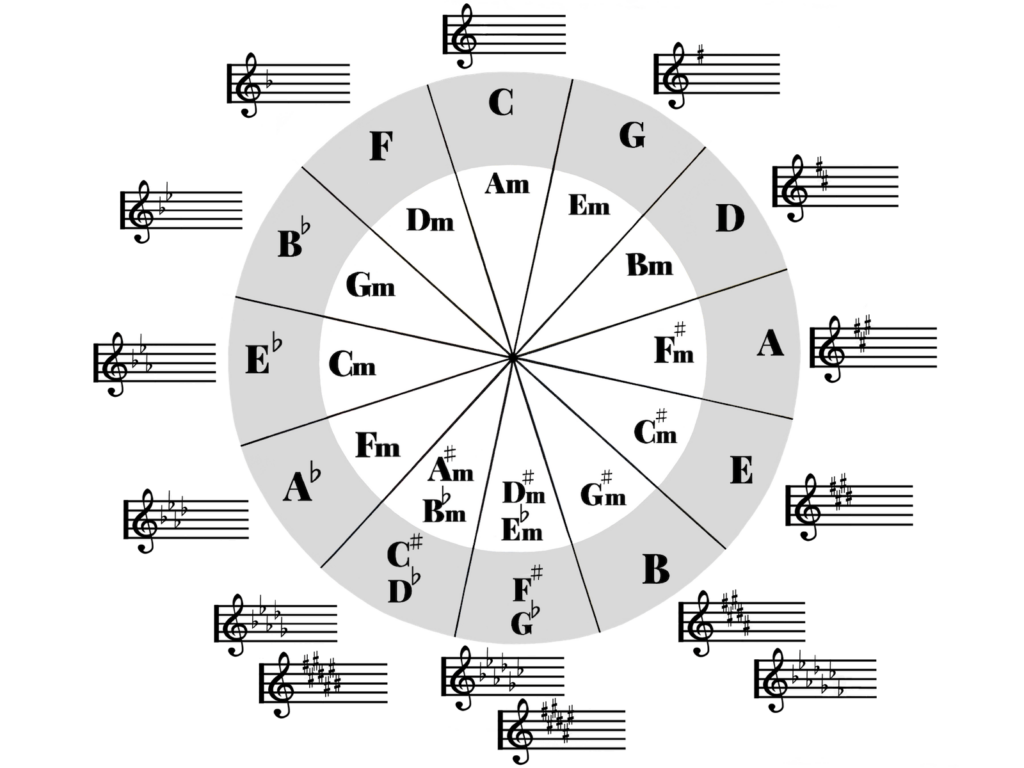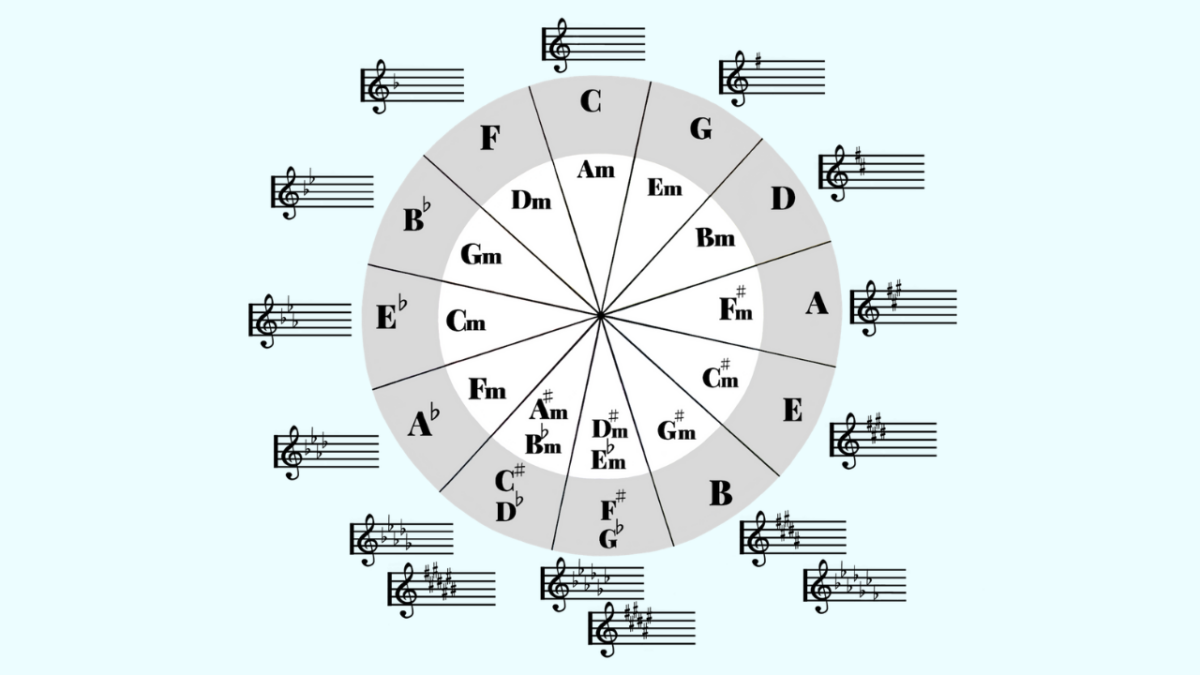The Circle of Fifths is a circular diagram that represents musical keys, known in Japanese as “五度圏 (Godoken)” or “五度圏図 (Godoken-zu).”
In this article, we will introduce the Circle of Fifths.
What is the Circle of Fifths?
The Circle of Fifths is a diagram that visually shows the relationships between keys in music.
A key represents the general scale system used in a piece of music. By using the Circle of Fifths, you can visually understand the closeness and transitions between keys.
Structure of the Circle of Fifths

The Circle of Fifths generally has the following structure:
- C major, with no sharps or flats, is located at the top of the circle.
- Moving clockwise adds sharps, while moving counterclockwise adds flats.
- The relative minor keys are placed inside the circle alongside their parallel major keys.
Why “Fifth”?
The “Fifth” in the Circle of Fifths refers to the Perfect Fifth in music theory.
It is the interval between a note and the fifth note above it in the scale. Arranging notes based on this “fifth” interval results in the Circle of Fifths.
The perfect fifth is one of the most stable intervals in music theory. This stability enables natural and harmonious modulation and chord progressions.
Keys and Modulation

Relationships Between Keys
Keys that share many of the same scale tones are called closely related keys. For example, from C major, the neighboring G major and F major are considered closely related.
The closer the relationship, the smoother and more natural the modulation becomes.
The Circle of Fifths helps visualize and understand these relationships, making smooth key changes easier to achieve.
How to Think About Key Relationships
Key relationships are mainly considered by focusing on the following three types:
(1) Relative Key
- A major key and its minor key that share the same scale.
- Example: C major and A minor are relative keys, both using a scale with no sharps or flats.
(2) Dominant Key
- The key whose tonic is a perfect fifth above the tonic of the original key.
- Example: The dominant key of C major is G major.
- The dominant key is based on the dominant chord, the most important chord after the tonic.
(3) Subdominant Key
- The key whose tonic is a perfect fifth below (or a perfect fourth above) the tonic of the original key.
- Example: The subdominant key of C major is F major.
These closely related keys are positioned next to each other on the Circle of Fifths.
What is Modulation?

Modulation is the technique of changing keys within a piece of music. Modulation to closely related keys sounds natural and does not feel strange to the listener.
On the other hand, modulation to distant keys creates surprise and dramatic effects.
Examples of Modulation Considering Key Relationships
(1) Modulation to the Relative Key
- Feature: Uses the same scale, making it the smoothest method of modulation.
- Example: Modulation from C major to A minor.
By slightly adjusting the choice of chords, a natural modulation can be achieved.
(2) Modulation to the Dominant or Subdominant Key
- Feature: Modulation is possible by adding just one sharp or flat to the scale.
- Example: Modulation from C major to G major (dominant) or F major (subdominant).
Since these keys are adjacent on the Circle of Fifths, the progression remains well-balanced and harmonious.
(3) Modulation to a Distant Key
- Feature: Produces a dramatic effect because the tonality changes significantly.
- Example: Modulation from C major to E major.
By passing through intermediate keys such as the dominant or relative key, it is possible to achieve a dramatic modulation while maintaining smoothness.
Using the Circle of Fifths for Modulation
By looking at the Circle of Fifths, you can instantly see the relationships between adjacent keys (closely related) and distant keys.
- Closely related keys: Adjacent on the Circle of Fifths. Ideal for smooth modulation.
- Distant keys: Located on the opposite side of the circle. Used when aiming for unexpected modulations.
Applications of the Circle of Fifths
The Circle of Fifths is not just a theoretical tool—it can be practically applied in the following ways.
Helpful for Practice

By practicing scales and chords in the order of the Circle of Fifths, you can efficiently master all keys.
For example, practicing major and minor scales in the order of the Circle of Fifths naturally helps you develop fingerings and understand scale relationships.
For Composition and Improvisation

When composing or improvising, the Circle of Fifths serves as a guide to smoothly modulate to closely related keys.
By using closely related keys, the flow of the music becomes natural and harmonized.
Pop and Classical Music
Modulation using relative or dominant keys is common.
The melody keeps a similar atmosphere while maintaining harmony.
Jazz and Contemporary Music
Bold use of distant keys creates surprise and originality.
Understanding Chord Progressions

The Circle of Fifths helps deepen understanding of common chord progressions in popular and jazz music, such as the circle progression (I-IV-V-I) and the II-V-I progression.
For example, the chord progression based on the Circle of Fifths in C major (C→G→F) appears in many songs.
Conclusion
The Circle of Fifths is a powerful tool for understanding and applying music theory.
It is easy to use even for beginners and can be applied to scale practice, composition, improvisation, and modulation.
By understanding key relationships and using the Circle of Fifths, you can expand your musical range and develop deeper expressive ability—so make the most of it and enjoy music even more!

